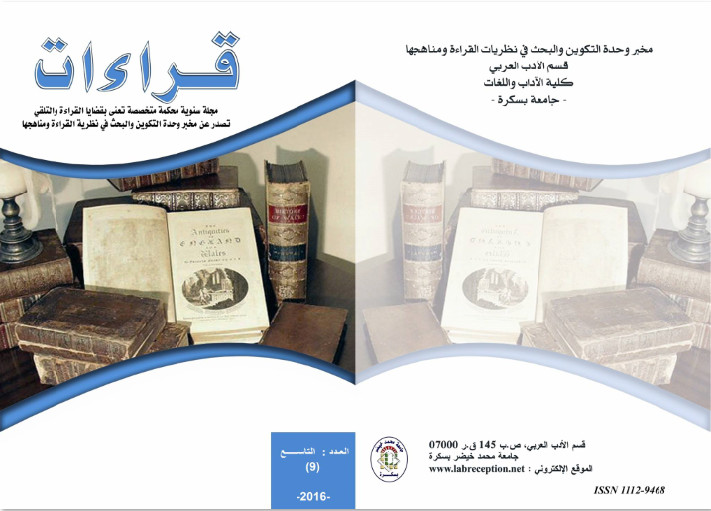التفكير اللغوي في سيمياء الشعر عند ميشال ريفاتير
Résumé
لا شك في أن أية مقاربة مأمولة للخطاب الأدبي تستند من قريب إلى المعرفة اللغوية، من حيث كون اللغة المادةَ الأساسية للأدب. وإذا كان مسعى القراءة النقدية الوقوف على أسرار اللغة المبدعة كان تفسير تلك الأسرار كامنا في آليات اللغة وطريقة اعتمالها في النصوص السردية والشعرية، وهذا بالنظر دائما إلى قارئ متفاعل. لقد جرت عادة المؤرخين للنقد أن يصنِّفوا آراء الناقد الفرنسي ميشال ريفاتير ضمن ما يعرف بالأسلوبية الشعرية، والأسلوب هو واحد من المفاهيم المحورية التي استمدها النقاد من قديم، إلا أنها عرفت في مرحلة ما من مراحل النقد المعاصرة تحولا نحو الوصف البنيوي للنص الأدبي، بداية من الاتجاه الشكلاني، وقد يعضد هذا التصنيف أن عمل ريفاتير على مستوى الخطاب الشعري كان منصبا على اللغة، كان اشتغاله على تحليل الأفق الإبداعي للغة الأدبية انطلاقا من عدم وفائها للقواعد اللغوية المعهودة في التواصل اليومي.
لكن العودة إلى كتاباته النقدية في ضوء ما يعرف بسيمياء الشعر يجعل الجزم بهذا التصنيف الصارم غير مأمون، لأن تحليل الأسلوب الأدبي في تجربته يعتمد على ثلاثة أبعاد متداخلة يمكن لأي قارئ حر أن يلحظها من خلال حواره مع القصائد الشعرية: البعد الأول لغة النص أو الأسلوب وهو عنصر فاعل في تحديد سمات الأدبية من غيرها، والبعد الثاني علاقة المفارقة بين تلك اللغة وبين الواقع أو المرجعية، والبعد الثالث في تحليل الخطاب الشعري هو العلاقة المترددة بين القارئ والنص. إذا صح تأصيل هذه الأبعاد الثلاثة في الممارسة النقدية كان التصنيف الجاهز في زمرة من زمر الاتجاهات النقدية عملا يفتقر للدليل.
There is no doubt that any approach of literary discourse must be based on a linguistic knowledge, in the fact that the language is the essential material of literary work. If the purpose of the critical reading is to describe the secrets of creative language, the interpretation of those secrets is hidden in the language mechanisms and the way of its interaction in the narrative and poetic texts , and this is when taking into account an interactive reader. It has been the historians of criticisms’ custom to classify the views of the French critic Michel Riffaterre in what is known poetic stylistic, and the style is one of the central concepts that critics derived from the old, but it has known in a stage from stages of the contemporary criticism a shift towards structural description of literary text, starting from formalistic trend, and this categorization can sustain that Riffaterre’s work at the level of poetic speech focused on the language, his concern was with the analysis of the creative horizon of literary language starting from its disloyalty with its usual linguistic rules in the daily communication.
But returning to his critical writings in the light of what is known Poem’s Semiotic makes the assertion of this strict categorization weak in its base , because the analysis of literary style in its experiment depends on three overlapped dimensions that any free reader can notice through his dialogue with poems: The first dimension is the language of the text or the style and it is an active element in determining literary characteristics from others, and the second dimension is the relationship between the differentiation of that language and reality, or reference, the third dimension in poetic discourse analysis is the tentative relationship between reader and text. If it is possible to root these three dimensions in the criticism practice the ready classification in a kind from the kinds of criticism trends will be a work that lacks methodology and evidence.


